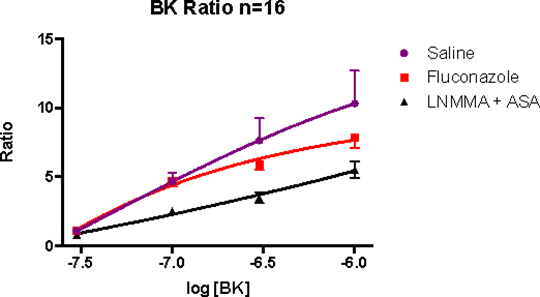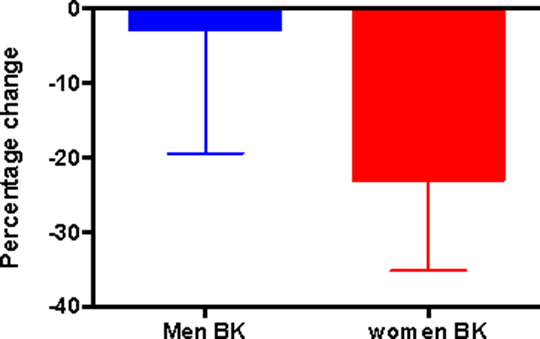Epoxyeicosatrienoic acids in the regulation of forearm blood flow Background: Epoxyeicosatrienoic acids (EETs) are formed from arachidonic acid by cytochrome P450 enzymes and rapidly hydrolysed by soluble epoxide hydrolase (sEH) enzymes. Like nitric oxide and prostacyclin, EETs are released from the endothelium and are involved in vasomotor regulation. EETs signaling is impaired in cardiovascular risk factor groups, and up-regulation of EETs with sEH inhibition have shown benefits in animal models of the metabolic syndrome, hypercholeterolaemia, and diabetes. We aimed to evaluate the ability of two challenge agents to stimulate EETs mediated vasodilatation, and assess any differences between men and women. Methods: Venous occlusion plethysmography with intra-arterial drug infusions was used to assess forearm blood flow [1]. Healthy volunteers (8 male, 8 female) were recruited for 3 forearm blood flow studies to compare the effects of bradykinin (100, 300, 1000pmol/min) and acetylcholine (6, 20, 60μg/min) co-infused with saline, fluconzole (cytochrome P450 inhibitor, 0.4μmol/min), or aspirin (cyclo-oxygenase inhibitor, 1g IV) plus L-monomethlarginine (nitric oxide synthase inhibitor, 8μmol/min). Data were analysed by repeated measures analysis of variance. Results: Acetylcholine and bradykinin both caused dose related vasodilatation (p<0.0001). Only bradykinin stimulated vasodilatation was significantly inhibited by fluconazole (p=0.01); figure 1. At bradykinin 1000pmol/min, fluconazole inhibited flow by 24% (p=0.02). Aspirin plus LNMMA significantly inhibited bradykinin more than acetylcholine stimulated vasodilatation (46% vs. 30%; p=0.02). The inhibitory effect of fluconazole on bradykinin stimulated vasodilatation was more marked in females; fig.2. 
Fig.2 Percentage change of stimulated flow with fluconazole inhibition 
Abbreviations: BK; bradykinin, ASA; aspirin, LNMMA; L-monomethylarginine Interpretation and discussion: Bradykinin stimulates EETs mediated vasodilatation more than acetylcholine. We will investigate EETs signaling in different cardiovascular risk groups using bradykinin. Females may release more EETs than men, and this requires further investigation. Reference: 1. Wilkinson IB & Webb DJ, Br J Clin Pharmacol. 52:631-46, 2001
|



